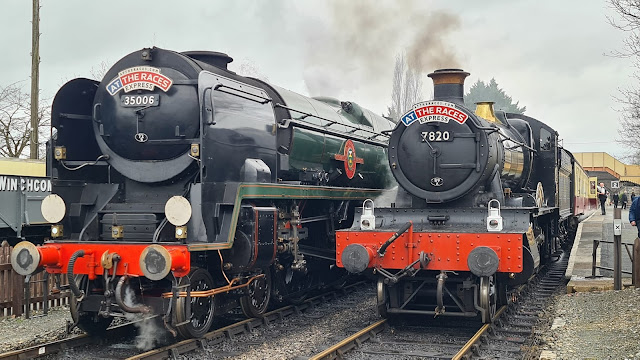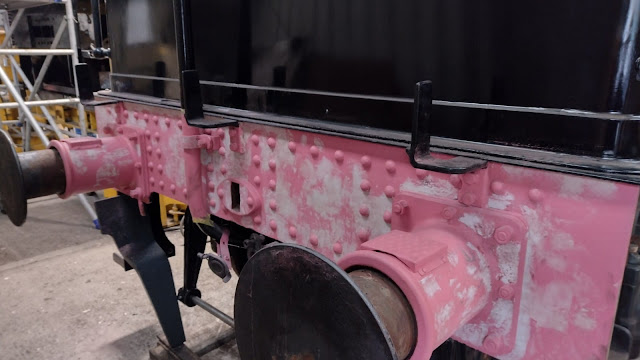Under starters orders! 35006 & 7820 prepare to depart for the Cheltenham Festival - Photo courtesy of Ade Showell
Good afternoon one and all and I trust that you are keeping well and enjoying the Spring sunshine, long may it continue! Although saying that, I can see some clouds approaching, thus I've probably gone and jinxed it now! Perhaps I should telephone Michael Fish and ask if there's a hurricane on the way? Anyway, that's enough talk about the British weather.
Time certainly flies by (or should that be steams by) when you're having fun and the past few months have been very busy for the steam locomotive department, mind you, I'd be hard pushed to find a time when we're not busy with one thing or another. It was a case of 'all-hands on shed' to get things spick and span for the start of the 2023 season which fell on the first weekend in March. The final week before we started operating involved a fair amount of cleaning, tinkering, testing (not to be confused with playing!) and the mandatory boiler inspections and any outstanding steam tests/exams.
Storing our locomotives in a dry and covered steam shed has many benefits as I've mentioned before (most notably protecting the engines and us from the elements during the winter months!). However, one very minor issue in the grand scheme of things is that dust and detritus from the shed quickly builds up on the fleet over time, due to the ongoing maintenance and restoration projects. Therefore, it's very important that we try and stay on top of the cleaning activities.
7820 'Dinmore Manor' rests inside the DP shed - 28th February 2023
Cleaning a locomotive is very much a manual affair and unlike some depots and facilities on the mainline railway network, we do not have a flash wash plant at our disposal. Despite my best efforts, unfortunately the showers in our changing area wont quite fit a locomotive in (something to add to the agenda for the next management meeting I think!). I personally find cleaning rather therapeutic and on a glorious sunny day it's good to stand back and admire the fruits of your labour, and spot the bits that you've missed cleaning (as they tend to stand out somewhat). However, on a very wet and miserable day, your efforts almost seem pointless and pretty futile but we do try our best all the same. It all adds up.
To new volunteers in the department with no prior experience of steam locomotives, the prospect of cleaning a locomotive can be a little daunting, although in reality it's actually more straightforward than you initially might suspect. What I tend to say to new members is to think of it as a bit like washing your own car or bike for example - it's essentially the same sort of process but simply on a much larger scale. It's important to treat our locomotives with care and respect as one would with your own possessions. Our fleet of engines are the stars of the show for visitors so they need to look their best.
In terms of how we do cleaning, well, we use wash & wax for the locomotive paintwork (boiler barrel, roof, cab sides and tender), and kerosene to clean below the running plate (wheels, motion, locomotive frames, buffer beams). All the above is generally done in a wipe-on wipe-off approach to leave a good shine behind and to prevent streaking. Having a hosepipe handy with good water pressure on tap certainly helps with washing things down afterwards. It's important that any areas where crews will be walking or stepping on are made thoroughly dry at the end to minimise the risk of anyone slipping.
The running plates and smokebox area are cleaned with a damp rags or a towel and carefully dried off once complete - both areas are also painted, hence the care required. The running plates tend to need a lot of work due to the amount of dirt that accumulates over time and recently we have been using traffic film remover which helps cut through the really stubborn stuff. The brass-work, nameplates and numberplates are cleaned either using Brasso or Peak - I find the latter works better as Brasso has a tendency to leave white marks behind which has to be cleaned off. The footplate is also given a good sweep and the loco controls and pipework receives the same Brasso/Peak treatment where applicable.
To give a really good shine, we apply coats of polish to the locomotive paintwork which really stands out in the sunshine.
Top Tip: Clean and re-oil the locomotive motion at the end after the engine has been disposed. Otherwise it's deja-vu!
To clean and polish a locomotive properly you really need a small team of people to help with each engine, and cleaning the fleet regularly helps with the workload. It's only when you get up close with these magnificent machines that you realise how much needs to be done. One day I felt a real sense of achievement when I'd cleaned the driver's side of 7820, only for it to dawn on me that I still had the fireman's side to do. There's a lot to be said for model railways! I say in jest!
Meanwhile, our friends from the diesel department and permanent way had been out and about on ballasting duties.
7820 being readied for her boiler inspection - Video courtesy of Mike Solloway - 2nd March 2023
With the home fleet being readied for service and inspections on Friday 3rd March, I thought I'd head down to assist as I usually do on a Friday. Unfortunately, I was in for an eventful morning and just getting down to Toddington turned out to be a rather challenging and nerve-wracking experience all in itself. As I was driving away from a roundabout on the A46 southbound I heard an almighty bang inside my car, followed by some serious resistance whenever I tried to accelerate, along with a rather uncomfortable droning noise - not particularly reassuring when you're travelling at around 50mph at the time on a dual-carriageway! With next to no power, my car quite evidently in 'limp mode' and sounding like a Flymo mower under the bonnet (I initially thought it was a car behind me with a dodgy exhaust), I managed to make it to shed!
Suffice to say, I didn't stay around long and after taking a few photographs below I decided to see if I could make it back home and to the local garage (sods law my MOT was due only a few days later). Trying to accelerate up a hill with next to nothing is not particularly pleasant. However, I survived the return journey and I'm still here to tell the tale as it were!
I'm pleased to report that the home locomotive fleet passed their tests with flying colours and 7820 operated the first service trains on the 4th & 5th March. 35006 & 7903 spent the weekend out on test runs to ensure that all of the winter maintenance tasks had been successful. If only the same could be said of my car, which required a new turbo diverter valve amongst other things. So much for 'German Reliability' and all that - a penny-farthing would seem a more reliable option at this point! Onwards and upwards as they say and let us move on to something rather more exciting... horses!
Speaking of horses, the second week of the month saw the arrival of some visiting horsepower in the form of No. 75014.
BR Standard Class 4 4-6-0 No. 75014 'Braveheart' arrives at Toddington - Photo courtesy of GWSR
The third week in March heralded the return of the Cheltenham Festival between the 14th & 17th which is always a great event for both the railway and festival goers. We saw a lot of visitors and many happy smiling faces (even before the odd drink or several had been consumed!). Don't worry, we don't drink and drive as far as our steam locomotives are concerned, well, other than being under the influence of tea and the odd bacon roll anyway! Hmm I wish I hadn't just typed that as now I'm hankering for my fix of bacon. Sadly, I've just been down and checked the fridge and there's none.
7820 'Dinmore Manor' - Video courtesy of Kevin Jarvis
This year's Cheltenham Festival brought a little bit more attention to the GWSR as we were very fortunate to be visited by ITV Racing, along with Charlotte Hawkins and Mark Hayes. Quite a lot of work 'off camera' went into organising the visit.
All aboard P&O - Ed, Ade, Charlotte, Jamie & Gwendolyne - Photo courtesy of Jamie Christie
ITV Racing on the GWSR at the Cheltenham Festival - Video courtesy of ITV
Here's a selection of photographs taken by our resident photographer and The Cornishman editor, Jack Boskett.
Paul at the controls of 35006
Approaching Cheltenham Racecourse - A race between P&O and the helicopter?
Approaching Cheltenham Racecourse - A race between P&O and the helicopter?
7820 runs through Greet en-route to Cheltenham Racecourse on Gold Cup day
7903 at Cheltenham Racecourse
As the light fades, the last 'At The Races' festival train heads out of Cheltenham Racecourse Station for Broadway on the 17th March 2023, with Modified Hall No. 7903 at the helm - Video courtesy of GWSR
BR Standard Class 4 4-6-0 No. 75014 'Braveheart' being shunted in Toddington yard - Photo courtesy of Andrew Stratford.
With the Cheltenham Festival in full swing, work on-shed continued with getting 75014 together and ready to run. All visiting locomotives to the GWSR must have a fitness to run exam (FTR), a steam test, and be weighed before they can enter active service. On Thursday 16th March, test runs were carried out between Toddington and Winchcombe to ensure all was well. Ben and Tom from the Paignton & Dartmouth, along with John & Ben took charge of the fun filled activities.
75014 sets off on a test run to Winchcombe - Video courtesy of Steve Parker
In restoration news, further progress had been made by mid-March on 3850 with both the tender and locomotive.
Tender brake hangers re-hung with tie-bars - Photo courtesy of Kenneth Sims
Tender rear buffer beam sanded and filled - Photo courtesy of Kenneth Sims
News from the footplate
In more recent department news we're delighted to report that Ed Brooks has now passed out as a driver. Well done Ed!
Right away driver! - Photo courtesy of Ed Brooks / Ray O'Hara
GWRT £1.5m Stanway Viaduct Appeal
On a completely different subject, please consider donating to the GWRT's £1.5m appeal for Stanway Viaduct if you can.
Further information about the appeal can be found on the Stanway Viaduct Appeal page. See here for details.
Important Note:
New websites were launched in February for both the GWSR and the
GWRT, thus any pre-existing bookmarks to the main blog page via the old
GWSR website will no longer work. The new websites can be found by
visiting https://www.gwsr.com/ (GWSR) and https://www.gwrt.org.uk/ (GWRT).
All of the departmental blogs can now be found on a new main blog page here: https://www.gwsr.com/knowledge/blogs
All of the departmental blogs can now be found on a new main blog page here: https://www.gwsr.com/knowledge/blogs
Until next time folks, there's another two months worth of stuff on the way so please stay tuned!
PS I'll leave you with the legendary Michael Fish - 15th October 1987 hurricane forecast
Alex (the sooty one!). All published photographs are my own unless otherwise stated/credited.

.jpg)
.jpg)

.jpg)
.jpg)
.jpg)
.jpg)




























